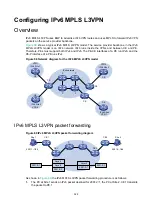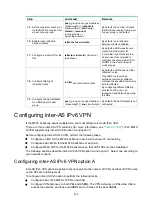
324
Protocols and standards
•
RFC 4659,
BGP-MPLS IP Virtual Private Network (VPN) Extension for IPv6 VPN
•
RFC 6565,
OSPFv3 as a Provider Edge to Customer Edge (PE-CE) Routing Protocol
IPv6 MPLS L3VPN configuration task list
Tasks at a glance
(Required.)
Configuring basic IPv6 MPLS L3VPN
(Optional.)
(Optional.)
(Optional.)
Configuring an OSPFv3 sham link
(Optional.)
Configuring BGP AS number substitution and SoO attribute
Configuring basic IPv6 MPLS L3VPN
The key task in IPv6 MPLS L3VPN configuration is to manage the advertisement of IPv6 VPN routes
on the MPLS backbone, including management of PE-CE route exchange and PE-PE route
exchange.
To configure basic IPv6 MPLS L3VPN:
Tasks at a glance
:
3.
(Required.)
4.
(Required.)
Associating a VPN instance with an interface
5.
(Optional.)
Configuring route related attributes for a VPN instance
(Required.)
Configuring routing between a PE and a CE
(Required.)
Configuring routing between PEs
(Optional.)
Configuring BGP VPNv6 route control
Configuration prerequisites
Before configuring basic IPv6 MPLS L3VPN, perform the following tasks:
1.
Configure an IGP on the PEs and P devices to ensure IP connectivity within the MPLS
backbone.
2.
Configure basic MPLS for the MPLS backbone.
3.
Configure MPLS LDP on PEs and P devices to establish LDP LSPs.
Configuring VPN instances
By configuring VPN instances on a PE, you isolate not only VPN routes from public network routes,
but also routes between VPNs. This feature allows VPN instances to be used in MPLS L3VPNs and
other network scenarios as well.
All VPN instance configurations are performed on PEs or MCEs.
















































